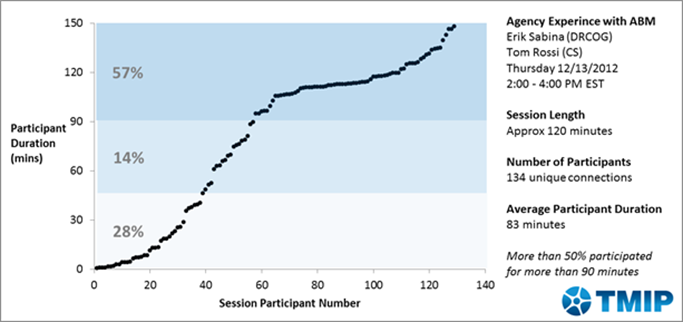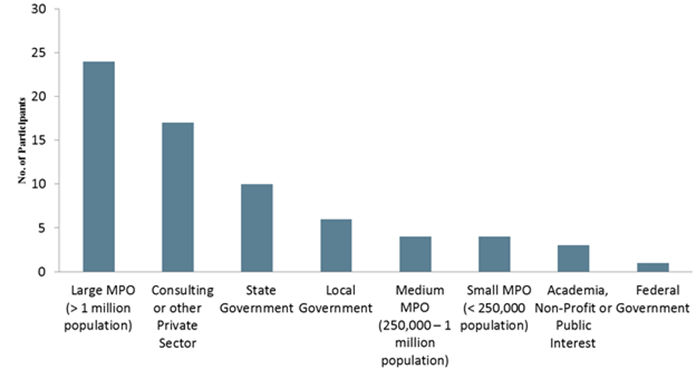On December 13, 2012, Travel Model Improvement Program (TMIP) sponsored a webinar highlighting Denver Regional Council of Governments (DRCOG) experience developing and applying their activity-based model. The webinar was titled "DRCOG Experience Using Activity-Based Models."
The webinar session was presented by Erik Sabina (Regional Modeling Manager at DRCOG) and Tom Rossi (Principal at Cambridge Systematics). They discussed DRCOG's activity-based travel model called 'Focus'. A range of topics were covered during the webinar including:
A total of one hundred and thirty four (134) individuals and agencies (some with more than one participant) from academia, private consulting firms, local, state, and federal governments attended the webinar. A majority of these participants worked for large MPOs (>1 million population), state governments, or private sector consulting firms.
In a post-webinar evaluation, more than 90% of the respondents agreed that the webinar was relevant to their day-to-day jobs and that the format of the webinar was just right as is. None of the participants experienced any major technical problems with the audio or video quality or service. As part of the open comments, a few attendees suggested that more MPOs or government agencies should present on how they are using advanced modeling techniques (such as activity-based models) in guiding their policy decisions.
The following sections provide a detailed evaluation of the TMIP webinar on DRCOG's Experience Using Activity-Based Models.
This webinar was promoted via an email message sent to the individuals and institutions who have signed up to receive TMIP news and updates (approximately 2000 subscribers). The promotional email was sent using GovDelivery, FHWA's news and email delivery service, on December 7, 2012. A reminder email was also distributed using GovDelivery on December 12, 2012, one day prior to the webinar. The webinar announcement and reminder distributed via email can be found in Appendix B.
Of the 134 unique attendees (meeting connections), 57% attended the webinar from start to finish (approximately 120 minutes). Figure 12 below presents a temporal profile of all the webinar participants.
Figure 12: Temporal Profile of DRCOG Agency Experience with ABM Webinar Participation

During the webinar, attendees were encouraged to submit questions via the meeting room chat pod. Eight (8) questions on the content of the presentations were asked in the chat. These questions are as follows:
These questions were answered once the presentation by Mr. Sabina and Mr. Rossi was complete.
Five (5) polling questions were administered as part of the webinar. The first question regarding the number of participants at each location was administered prior to the start and again at the end of the presentation. This was done to capture any additional participants that might have joined in during the course of the webinar. The remaining four questions were answered at the end of the presentation. The results of these questions are listed below.
Question 1
How many participants are there at your location?
Table 18: DRCOG Agency Experience with ABM Evaluation Poll Question-Number of Participants
| Response Options | Response | Weight | Percentage |
|---|---|---|---|
| 1 (just me) | 59 | 1 | 86% |
| 2 | 8 | 2 | 12% |
| 3 | 1 | 3 | 1% |
| 4 | 1 | 4 | 1% |
| 5 | 0 | 5 | 0% |
| 6 | 0 | 6 | 0% |
| 7 to 20 | 0 | 13 | 0% |
| Total | 69 | - | 100% |
The response to this question was used to assign a weight to all of the other responses provided by the attendees except the final question. The final question inquired about the role of the attendee himself/herself or the head of the group that was attending at the organization to which s/he (they) belonged and thus did not need to be weighted.
Question 2
How relevant was this webinar to your day-to-day job?
Table 19: DRCOG Agency Experience with ABM Evaluation Poll Question - Webinar Relevancy
| Response Options | Response | Percentage |
|---|---|---|
| Very | 42 | 61% |
| Somewhat | 25 | 36% |
| Not Very | 2 | 3% |
| Total | 69 | 100% |
A majority of the respondents found the webinar to be very useful at their current job.
Question 3
What changes would you like to see in the format?
Table 20: DRCOG Agency Experience with ABM Evaluation Poll Question - Webinar Format
| Response Options | Response | Percentage |
|---|---|---|
| More Time for Questions and Answers | 0 | 0% |
| More Presentation Time | 5 | 7% |
| Just About Right As Is | 64 | 93% |
| Total | 69 | 100% |
A vast majority of the participants agreed that the webinar format does not need to be changed in any way.
Question 4
What type of organization do you work for?
Figure 13: DRCOG Agency Experience with ABM Evaluation Poll Question-Type of Organization

As stated earlier, a majority of the attendees of this webinar were from large MPOs, state government, or the private sector consulting firms.
Question 5
Which of the following best describes you?
Table 21: DRCOG Agency Experience with ABM Evaluation Poll Question - Role at Organization
| Response Options | Response | Percentage |
|---|---|---|
| I apply and maintain travel demand models (hands on involvement) | 33 | 59% |
| I manage a group primarily responsible for model applications and maintenance | 5 | 9% |
| I manage/direct a group in which travel modeling is one of multiple technical services | 6 | 11% |
| I'm an executive director of an agency | 0 | 0% |
| I'm a model developer (design, estimate/calibrate, test) | 3 | 5% |
| I'm a developer of application software to support travel models | 3 | 5% |
| I manage a model development group or practice | 6 | 11% |
| I conduct or oversee research related to travel modeling | 0 | 0% |
| Total | 56 | 100% |
Participant response to the webinar was generally very positive. As indicated by the unedited comments below, the participants hoped that more MPOs and government agencies would continue to present these policy and procedural overview and other advanced modeling (especially activity based modeling) webinars. Some of the other primary recommendations from the participants were:
The participants hoped that more MPOs and government agencies would continue to present these policy and procedural overview and other advanced modeling (especially activity based modeling) webinars.